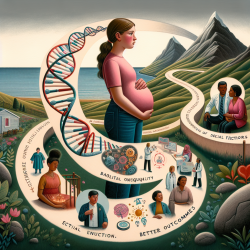Introduction
Adolescent pregnancy is a significant public health concern worldwide, affecting millions of young girls and perpetuating social inequities across generations. Traditional interventions have focused on modifying individual behaviors, but emerging research suggests that addressing upstream social and biological causes is crucial for more effective outcomes. This blog explores the findings from the research article "Social and Biological Transgenerational Underpinnings of Adolescent Pregnancy" and how practitioners can use these insights to improve their interventions.
Understanding the Complex Causes
The research highlights that adolescent pregnancy is not merely a result of individual choices but is influenced by complex interactions between socio-structural and ecological factors. These include housing and food security, family structure, and gender-based power dynamics. The study merges three theoretical frameworks—Eco-Social Theory, Life History Theory, and Developmental Origins of Health and Disease—to provide a comprehensive understanding of these interactions.
Implications for Practitioners
Practitioners are encouraged to shift their focus from individual behavioral interventions to addressing the broader socio-structural and ecological factors that contribute to adolescent pregnancy. This involves:
- Promoting stable and safe environments starting at conception.
- Improving economic and social equity.
- Addressing gender-based power imbalances and violence.
By targeting these upstream causes, practitioners can help reduce the prevalence of adolescent pregnancy and its associated risks.
Encouraging Further Research
The study also emphasizes the need for further research into the biological mechanisms linking socio-structural exposures to reproductive maturation. Understanding these mechanisms can inform the development of more effective interventions. Practitioners are encouraged to explore the following areas:
- The role of epigenetic processes in reproductive development.
- The impact of stress on the hypothalamic-pituitary-adrenal (HPA) axis and its interaction with reproductive systems.
- The timing of socio-structural exposures and their transgenerational effects.
Conclusion
Adolescent pregnancy is a complex issue that requires a comprehensive approach to address its root causes. By incorporating the insights from this research, practitioners can develop more effective interventions that not only reduce the prevalence of adolescent pregnancy but also improve outcomes for young mothers and their children. To read the original research paper, please follow this link: Social and Biological Transgenerational Underpinnings of Adolescent Pregnancy.










